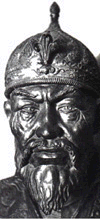Tamerlane (poem) Contents Synopsis Analysis Publication history References External links Navigation menuOriginal 1829 version of "Tamerlane" at www.eapoe.orgTamerlanee
1827 poemsPoetry by Edgar Allan PoeWorks published anonymously
Edgar Allan PoeTurkicTamerlaneTurkicTamerlaneLatinizedwarlordTimurid EmpireAda LovelaceLord ByronSarah Elmira RoysterEliza PoeUniversity of VirginiaRichmond, VirginiapseudonymFannyTo ——endnotes
"Tamerlane" is a poem by Edgar Allan Poe which follows a fictionalized accounting of the life of a Turkic conqueror historically known as Tamerlane. The poem was first published in the 1827 collection Tamerlane and Other Poems. That collection, with only 50 copies printed, was not credited with the author's real name but by "A Bostonian". The poem's original version was 403 lines but trimmed down to 223 lines for its inclusion in Al Aaraaf, Tamerlane, and Minor Poems.
Contents
1 Synopsis
2 Analysis
3 Publication history
4 References
5 External links
Synopsis
The poem follows the life of a Turkic conqueror historically known as Tamerlane. The name is a Latinized version of "Timur Lenk", the 14th-century warlord who founded the Timurid Empire, though the poem is not a historical depiction of his life.
Tamerlane ignores the young love he has for a peasant in order to achieve power. On his deathbed, he regrets this decision to create "a kingdom [in exchange] for a broken heart". The peasant is named Ada in most of Poe's original version of the poem, though it is removed and re-added throughout its many revised versions.[1] The name "Ada" is likely a reference to Ada Lovelace, the daughter of Lord Byron, a renowned poet whom Poe admired. In fact, the line "I reach'd my home — my home no more" echoes a line in Byron's work Don Juan.[2]
Analysis

"Tamerlane" is the Latinized name of a 14th-century historical figure.
The main themes of "Tamerlane" are independence and pride[3] as well as loss and exile.[4] Poe may have written the poem based on his own loss of his early love, Sarah Elmira Royster,[5] his birth mother Eliza Poe, or his foster-mother Frances Allan.[4] The poem may also mirror Poe's relationship with his foster-father John Allan; similar to Poe, Tamerlane is of uncertain parentage, with a "feigned name."[6] Only 17 when he wrote the poem, Poe's own sense of loss came from the waning possibility of inheritance and a college education after leaving the University of Virginia.[4] Distinctly a poem of youth, the poem also discusses themes Poe will use throughout his life, including his tendency toward self-criticism and his ongoing strivings towards perfection.[3]
The poem was influenced by Lord Byron's drama Manfred and his poem The Giaour in both manner and style.[7]
Poe may have first heard of Timur in July 1822 as a young man in Richmond, Virginia. A horse-spectacle called Timour the Tartar was staged at the Richmond theatre and repeated in October. Some Poe scholars speculate Poe was in attendance or at least heard of the show.[8]
Poe may have identified with the title character. He used "TAMERLANE" as a pseudonym attached to two of his poems on their first publication, "Fanny" and "To ——," both published in the Baltimore Saturday Visiter in 1833.
Publication history
"Tamerlane" was first published in Poe's earliest poetry collection, Tamerlane and Other Poems. The "little volume", as Poe referred to it in the preface, consists of 10 poems.[9] This original version of the poem contained 406 lines. In an 1845 publication, it had been edited to only two hundred and thirty-four.[3]Tamerlane and Other Poems, which appeared in June 1827, was forty pages long and credited only by "a Bostonian".[10]
In its initial publication in the collection Tamerlane and Other Poems, Poe included endnotes explaining some of his allusions from "Tamerlane". He also confesses early on that he knows little about the historical Tamerlane, "and with that little, I have taken the full liberty of a poet". These endnotes do not appear in any other collection that includes "Tamerlane".
References
^ Quinn, Arthur Hobson. Edgar Allan Poe: A Critical Biography. Baltimore: The Johns Hopkins University Press, 1998. p. 124. .mw-parser-output cite.citationfont-style:inherit.mw-parser-output .citation qquotes:"""""""'""'".mw-parser-output .citation .cs1-lock-free abackground:url("//upload.wikimedia.org/wikipedia/commons/thumb/6/65/Lock-green.svg/9px-Lock-green.svg.png")no-repeat;background-position:right .1em center.mw-parser-output .citation .cs1-lock-limited a,.mw-parser-output .citation .cs1-lock-registration abackground:url("//upload.wikimedia.org/wikipedia/commons/thumb/d/d6/Lock-gray-alt-2.svg/9px-Lock-gray-alt-2.svg.png")no-repeat;background-position:right .1em center.mw-parser-output .citation .cs1-lock-subscription abackground:url("//upload.wikimedia.org/wikipedia/commons/thumb/a/aa/Lock-red-alt-2.svg/9px-Lock-red-alt-2.svg.png")no-repeat;background-position:right .1em center.mw-parser-output .cs1-subscription,.mw-parser-output .cs1-registrationcolor:#555.mw-parser-output .cs1-subscription span,.mw-parser-output .cs1-registration spanborder-bottom:1px dotted;cursor:help.mw-parser-output .cs1-ws-icon abackground:url("//upload.wikimedia.org/wikipedia/commons/thumb/4/4c/Wikisource-logo.svg/12px-Wikisource-logo.svg.png")no-repeat;background-position:right .1em center.mw-parser-output code.cs1-codecolor:inherit;background:inherit;border:inherit;padding:inherit.mw-parser-output .cs1-hidden-errordisplay:none;font-size:100%.mw-parser-output .cs1-visible-errorfont-size:100%.mw-parser-output .cs1-maintdisplay:none;color:#33aa33;margin-left:0.3em.mw-parser-output .cs1-subscription,.mw-parser-output .cs1-registration,.mw-parser-output .cs1-formatfont-size:95%.mw-parser-output .cs1-kern-left,.mw-parser-output .cs1-kern-wl-leftpadding-left:0.2em.mw-parser-output .cs1-kern-right,.mw-parser-output .cs1-kern-wl-rightpadding-right:0.2em
ISBN 0-8018-5730-9 ("Quinn").
^ Silverman, Kenneth. Edgar A. Poe: Mournful and Never-ending Remembrance. Harper Perennial, 1991. p. 41 ("Silverman").
^ abc Quinn, p. 122.
^ abc Hoffman, Daniel. Poe Poe Poe Poe Poe Poe Poe. Baton Rouge: Louisiana State University Press, 1972. p. 27.
ISBN 0-8071-2321-8.
^ Sova, Dawn B. Edgar Allan Poe: A to Z. Checkmark Books, 2001.
^ Silverman, p. 39.
^ Campbell, Killis. "The Origins of Poe", The Mind of Poe and Other Studies. New York: Russell & Russell, Inc., 1962: 150.
^ Thomas, Dwight & David K. Jackson. The Poe Log: A Documentary Life of Edgar Allan Poe, 1809–1849. Boston: G. K. Hall & Co., 1987: 52.
ISBN 0-7838-1401-1.
^ Silverman, p. 38–39.
^ Silverman, p. 38.
External links
Wikisource has original text related to this article: Tamerlane |
Wikisource has original text related to this article: Tamerlane and Other Poems/Endnotes |
- Original 1829 version of "Tamerlane" at www.eapoe.org
 Tamerlane public domain audiobook at LibriVox
Tamerlane public domain audiobook at LibriVox